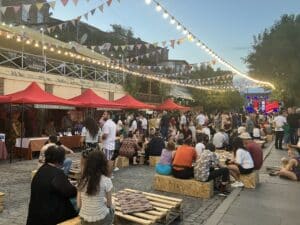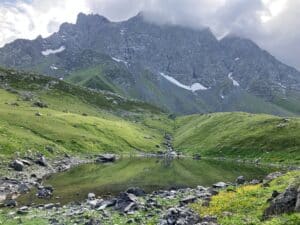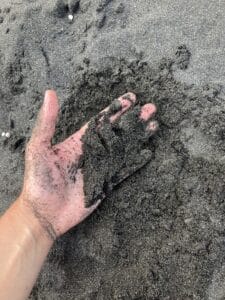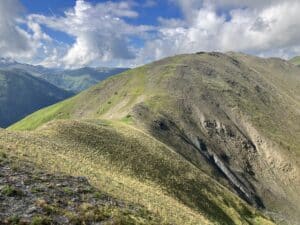Over the summer of 2023, I made a 3-month backpacking journey hiking across the Caucasus, spending time in all three Caucasus countries. This article is on Georgia and breaks down my time in the country region by region. If you are interested in the other parts of my trip, you can check out my intro page where I share some information on how I planned this trip or my articles specifically on Armenia and Azerbaijan.
In all of these, one of my primary purposes was to hike the majestic Caucuses – so you’ll notice that I spend a lot of time moving around on foot. I also give advice on how to explore the villages and cities via transport.
For any hikes in Georgia I’d recommend the Caucasus trekking site – they have all the trail information and GPX files.
This was my second time in Georgia: the first was in 2022 as part of a SRAS summer study abroad program. I focused this solo trip on places I hadn’t been before and exploring new parts of those I already knew.
Tbilisi
Tbilisi is my favorite city I have been to in any country – it is youthful, colorful, approachable, and urban while still wonderfully capturing the “old soul” atmosphere with clear influences from the Soviet era. One of my favorite things about Tbilisi is how it represents the vibrant and exciting intersection of European and Asian cultures. In my opinion, Tbilisi deserves at least four days of attention by travelers; it is more vast than many realize. The central part offers well-known attractions such as Old Town, Freedom Square, the sulfur baths, flea markets, and Rike Park. However, if you take the metro and branch out you can discover hidden gems such as old Soviet-style apartments connected by metal pedestrian bridges and Lisi Lake. I went through the hassle of getting to this lake almost every day of my last week in Tbilisi to enjoy swimming during the hot day. You can also explore the city by joining one or more of their free walking tours.
For accommodation, Sheni Hostel is perfect for a solo traveler: great location, hard-to-beat price, and easy-going. It is a five minute walk from one of the main metro stations and less than a twenty minute walk from Old Town. The place is not overly crowded, so it is a great place to chill during the day and has a welcoming common area and staff.
Kakheti
Kakheti is arguably Georgia’s most famous wine region. One of its small towns is Sighnaghi, 1-2 hours on marshrutka north of Tbilisi. Sighnaghi has been nicknamed Georgia’s “City of Love” and has a wedding house where couples can marry on any day at any time. The cobblestone streets, side markets, wooden balconies, and colorful buildings contribute to a welcoming and romantic atmosphere. The City Wall, built in the 13th century, offers incredible panoramic views over Alazani Valley and has a section tourists can walk along for free. St. George Church, St.Stephen Church, Bodbe Convent, and St. Nino Spring are all located nearby as well and make for great day activities.
I highly recommend Nato & Lado, a cozy guesthouse located right in the center of Sighnaghi. I loved it so much that I changed my plans to return for a couple extra days after I went hiking in Tusheti. The terrace offers beautiful views of the mountains and town, and the outdoor common area is inviting with its brick walls decorated in postcards their guests have sent from all over the world. During September, Nato and Lado (the couple who run the guesthouse) take their guests to their vineyard to harvest grapes and make wine – all for free as part of having a great experience! Nato and Lado are some of the nicest hostel owners I have ever met; I even still keep in touch with their daughters. They also have their own tour company for those seeking additional activities.
Tusheti
Tusheti is the most isolated region of the entirety of Georgia. It is tucked away in the northeast corner of the country and is accessible via the Abano Pass – which is often closed in winter. This long, zig-zagging road is Georgia’s most dangerous road and one of the highest drivable ones in the Caucasus at over 2820 m. I reached the region by hitchhiking with some local boys of my age I met in Alavani, one the closer cities at the start of the Pass. From Sighnaghi, you can take a marshrutka to Telavi and then bus from there to Alavani where you can see if there are any locals heading up the Pass with whom you can hitchhike.
Tusheti, to be completely honest, is not the first place I would recommend to people traveling to Georgia. Perhaps this is related to the difficulty in finding transportation to and from the region, but overall it did not stand up to its mountainous counterparts in Kazbegi and Svaneti. There is one main hiking loop around the region (a combination of trails from Upper Omalo going through Dartlo and Dikhlo) which mostly follows jeep tracks. The people in the larger villages treated me like a tourist and were not open to helping me find affordable sources of food (they even wanted to charge me for hot water for tea). The kindest people I found were in Chigho, a very small village I passed through on my second day of hiking, who prepared me fresh khachapuri as I was practically starved. Other hikers I talked with had more positive experiences in Tusheti, though, so it may simply depend on your luck. I cannot deny the gorgeous views Tusheti offered of grassy mountains, forests, rivers, and more wildflowers than I saw anywhere else in Georgia. I wrote to several of my friends about how I felt that they could film a Disney movie here because the slopes were covered in so many flowers and butterflies.
Kazbegi
Kazbegi is one of Georgia’s most popular hiking destinations. With lakes, churches, and towering mountains, it is a scenic area and boasts the benefit of being only a couple hours from Tbilisi by marshrutka. The best known hiking destination in Kazbegi is Gergeti Trinity Church near the townlet of Stepantsminda. Stepantsminda reminded me geographically of Sheki in Azerbaijan in the sense that the town is encircled by mountains. I only spent one night there and did not have the chance to visit the church as I opted for a two-day loop between the villages of Juta and Roshka.
This hike was everything I could have wanted – exhausting, exhilarating, and rewarding. It is not for the faint of heart, but you will be breath-taken by the stunning Chaukhi Massif at over 3300 m, the three-colored Adubelauri lakes, and the contrast between dark gray cliffs, sheets of glistening white ice, and bright green slopes. When I arrived in Roshka at the end of a 25km day, none of the guesthouses had any availability, but a family at one of them set me up to sleep in their attic and offered me plov for dinner.
I hitchhiked to and from Juta (my starting and end point), although it is also possible to reach it by foot from Stepantsminda (the walk takes 2-3 hours). I would recommend stocking up on food in Stepantsminda as Juta does not have any markets, and the one restaurant is a little overpriced (although the food is good). I was stuck in Juta for an extra day before I started hiking because I got sick, so I had no other food options except that restaurant while there. There are also a plethora of additional opportunities to admire nature and explore the mountains in Kazbegi, such as Kazbek Peak and Darialia Gorge.
Adjara
The city of Batumi is equivalent to nostalgia for me at this point. This is where I had studied Russian the previous summer with SRAS. So, the first place I stopped by was the NovaMova School to say hello (or “privet”) to my former instructor.
Batumi is one of Georgia’s more touristic cities but is not overwhelmingly large. You can reach it by marshrutka or train from Tbilisi. One of my favorite pastimes is to walk the Batumi Boulevard at night. Strolling by the sea and feeling the cool evening breeze is such a relaxing way to end a long day. Other popular sites in the city include the Alphabet Tower at Miracle Park, the Ali and Nino monument, Piazza square, Europe Square, the botanical gardens, and the dolphinarium. Mtirala National Park is not too far away for those wanting to explore a Georgian rain forest!
One of my favorite restaurants in Batumi is Sazandari. They offer an array of traditional Georgian salads, soups, meats, and drinks. My study abroad group in 2022 frequented this place quite often. Also, if you’re having a khachapuri craving, Laguna is definitely the place to go.
Batumi is also where I had to deal with some arising health concerns on my trip this summer. When I was hiking in Kazbegi, I began feeling very ill, so I took the time while I was in Batumi (a larger city) to visit the hospital. It was not anything too serious, and after a couple tests and consultations, the doctor prescribed me some medications to pick up from the local pharmacy. It turned out I had been exerting myself too strenuously and not eating well enough. It was a good reminder that health and nutrition are important components of long-term travel that we overlook sometimes when on the road.
If you have time, I’d suggest stopping by Ureki (you can get there by bus from Batumi). Ureki has black sand beaches, so the contrast in colors because the sand and sea is beautiful. Many will also tell you that the magnetic properties of the black sands here provide health benefits for one’s metabolism, joints, and inflammation. Don’t be surprised if you see a lot of people covering themselves in the sand!
Svaneti
Svaneti is a mountainous region in northwest Georgia along the border with Russia and has slowly been gaining fame in the international hiking and skiing communities. This part of the Caucasus range has snow-capped mountains, glaciers, forests, gorges, and stunning views. The region boasts a plethora of hiking options from easy day-hikes to extreme multi-day treks. One of Svaneti’s distinctive features is the Svan towers. These small defensive stone towers date from as early as the 9th century.
Some hikes I have completed in Svaneti include a variation of the Mestia-Ushguli four day trek, Chubadeshi viewpoint in Ushguli, and Chalaadi Glacier in Mestia. The Mestia-Ushguli trek is wonderful for beginners as the traditional trail offers guesthouse accommodation for each night, and the trail itself is not too technically difficult but still offers breathtaking views. The variation I opted for included camping at Khalde Glacier instead of passing through Iprali, but I would only recommend this option for experienced trekkers since the trail becomes completely unmarked, you probably won’t see a single other person on this path, there is no cell phone service, and you will deal with a lot of overgrown plants and potentially dangerous hogweed. There were sections where I had to push my backpack up the hill and then literally pull myself up by the grass in order to get out of the gorge which follows most of the route on the second day. It was definitely a Type 2 fun experience.
What I Ate
I ate at restaurants the most in Georgia of the three Caucasus countries I went to. Part of it was the nostalgia of going to places I had been the previous year, another part was me wanting a break in my diet. Hiking food was mostly Imeretian (cheese) khachapuri, lobiani (bean stuffed flatbread), peanut butter, and dates. My go-tos for hostel life never change: yogurt, oats, dark chocolate, ramen, and lots of fruit. I tried kubdari for the first time in Ushguli and would highly recommend it – it’s a Svaneti version of khachapuri filled with ground meat instead of cheese
Spending
Here is the breakdown of my costs across five weeks in Georgia. As a disclaimer, I tend to travel frugally, i.e stay in cheap hostels, eat basic street and grocery store food (although I went to a couple restaurants in Georgia as well), and occasionally hitchhike.
- Accommodation: $350
- Food: $250
- Transport: $120
- Miscellaneous: $45
- Bus to Yerevan: $19
- Total: $784
You Might Also Like

Hiking the Caucasus
Summer of 2023 – a summer I spent as a solo female budget backpacker traversing across the three Caucasus republics of Azerbaijan, Georgia, and Armenia. My trip focused on hiking and meeting locals in these three very different countries. It was arguably the most ambitious and most rewarding undertaking of my life so far, and […]

Batumi: Discover Georgian Food While Abroad!
One of the most exciting things about travel is the ability to try new combinations of flavors and textures! Local food can not only delight your senses, but also introduce you to important parts of the local culture and history. Georgian food is one of those cuisines that are exotic and yet everyone Study, eat, […]

Learning Russian with SRAS in Batumi, Georgia
In the summer of 2017 I attended the 2017 SRAS Russian as a Second Language program in Batumi, Georgia. My heart had always been set on studying in Saint Petersburg, but after researching various SRAS programs to see what else was available and looking at photos of Georgia and the Black Sea I could not […]

Batumi Beauty
Amidst the excitement of studying abroad, students often seek unique experiences. Imagine combining the thrill of exploration with the indulgence of self-care. In this tale, students embark on an unconventional journey, where cultural immersion intertwines with the soothing rituals of nail artistry. Dona Nail 51 Tbel-Abuseridze St Review by SRAS Student Marina Garfield When I […]

The Street Dogs of Georgia
Georgia is one of SRAS’ fastest growing study abroad locations. Students that head to Batumi or Tbilisi return home with incredible stories of a friendly, architecturally interesting city, fabulous food, breathtaking mountain adventures, and, very often… dogs. Georgia’s stray dogs are remarkably well-kept by Georgian society. They are generally well-fed, well-behaved, and even fully vaccinated. […]





























